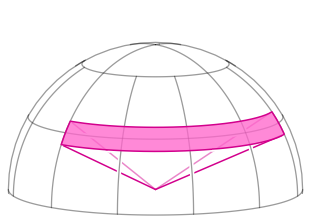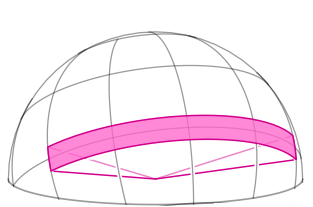VisibilityOperator.VerticalRotationAxis Property
Gets or sets a flag that determines the exact shape of the rectangular cross-section of the lobe. Use True for a radar system with a vertical rotation axis; use False for a camera with fixed orientation.
Syntax
public AttributeVariable< System.Boolean > VerticalRotationAxis { get; set; }Property Value
Default: true
A Bool representing exactly how PictureWidth and PictureHeight determines the rectangular cross-section of the sensor lobe.
Remarks
Imagine that the sensor is placed in the center of a terrestrial globe. The lobe will always be limited by two globe meridians separated by PictureWidth, and by two globe parallel circles separated by PictureHeight. The orientation of the globe depends on VerticalRotationAxis.
 |
If VerticalRotationAxis evaluates to True, then the globe axis is vertical. For example, if pictureElevation is 30° and pictureHeight is 10°, then the sensor lobe will be limited by the latitude circles at 25° and 35° degrees north.
 |
If VerticalRotationAxis evaluates to False, then the globe axis is tilted so that the ray through the center of the sensor lobe goes through the globe equator, and the globe axis is in the same vertical plane as that ray. For example, if pictureElevation is 30° and pictureHeight is 10°, then the sensor lobe will be limited by the latitude circles at 5° north and 5° degrees south, and the North Pole of the globe will be tilted 30°.
In the images above, the observer is at ground level, so the bottom half of the terrestrial globe is below ground and not displayed. The graticule of the globe has 30° spacing. The picture direction is mainly toward us, but slightly to the right: note that the ray from the observer through the center of the lobe goes in the same direction in both cases.
Another example: suppose an airplane flying north has a fixed camera directed straight down, giving a picture that covers 10° fore-to-aft and 20° port-to-starboard. If the airplane then gets a roll angle of r degrees, with a positive roll meaning starboard up, then the camera orientation is defined by
property | value |
|---|---|
90° (east) | |
r - 90° | |
20° | |
10° | |
False |
When you want to model a fixed camera by setting VerticalRotationAxis = False, you may expect to get a perfect rectangle as the cross section of the sensor lobe with a plane perpendicular to the central line through the lobe. However, since the sensor lobe is always defined to intersect the surrounding terrestrial globe along two meridians and two parallel circles, you will just get an approximate rectangle whose upper and lower edges are somewhat concave. But the deviation from a perfect rectangle is usually fairly small.
Platforms
Windows, Linux, Android